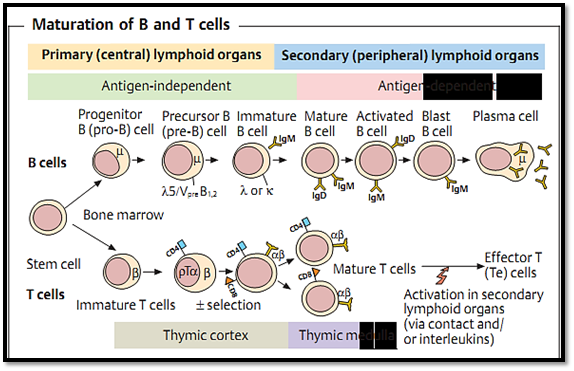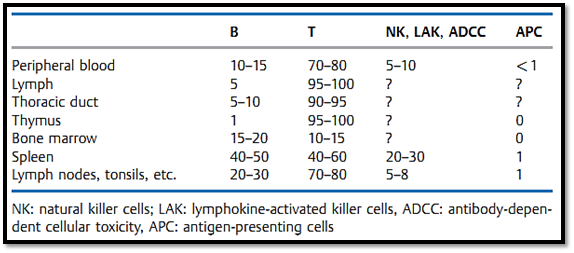


 النبات
النبات
 الحيوان
الحيوان
 الأحياء المجهرية
الأحياء المجهرية
 علم الأمراض
علم الأمراض
 التقانة الإحيائية
التقانة الإحيائية
 التقنية الحيوية المكروبية
التقنية الحيوية المكروبية
 التقنية الحياتية النانوية
التقنية الحياتية النانوية
 علم الأجنة
علم الأجنة
 الأحياء الجزيئي
الأحياء الجزيئي
 علم وظائف الأعضاء
علم وظائف الأعضاء
 الغدد
الغدد
 المضادات الحيوية
المضادات الحيوية|
Read More
Date: 9-12-2015
Date: 8-11-2015
Date: 9-12-2015
|
The Immunological Apparatus
The immune system is comprised of various continuously circulating cells (T and B lymphocytes, and antigen-presenting cells present in various tissues). T and B cells develop from a common stem cell type, then mature in the thymus (Tcells) or the bone marrow (B cells), which are called primary (or central) lymphoid organs. An antigen-specific differentiation step then takes places within the specialized and highly organized secondary (or peripheral) lymphoid organs (lymph nodes, spleen, mucosa-associated lymphoid tissues [MALT]). The antigen-specific activation of B and/or T cells involves their staggered interaction with other cells in a contact-dependent manner and by soluble factors.
B cells bear antibodies on their surfaces (cell-bound B-cell receptors). They secrete antibodies into the blood (soluble antibodies) or onto mucosal surfaces once they have fully matured into plasma cells. Antibodies recognize the three-dimensional structures of complex, folded proteins, and hydrocarbons. Chemically, B-cell receptors are globulins (“immunoglobulins”) and comprise an astounding variety of specific types. Despite the division of immunoglobulins into classes and subclasses, they all share essentially the same structure. Switching from one Ig class to another generally requires T-cell help.
T cells recognize peptides presented on the cell surface by major histocompatibility (gene) complex (MHC) molecules. A T-cell response can only be initiated within organized lymphoid organs. Naive T cells circulate through the blood, spleen, and other lymphoid tissues, but cannot leave these compartments to migrate through peripheral nonlymphoid tissues and organs unless they are activated. Self-antigens (autoantigens), presented in the thymus and lymphoid tissues by mobile lymphohematopoietic cells, induce T-cell destruction (so-called negative selection). Antigens that are expressed only in the periphery, that is outside of the thymus and secondary lymphoid organs are ignored by T cells; potentially autoreactive T cells are thus directed against such self antigens. T cells react to peptides that penetrate into the organized lymphoid tissues. New antigens are first localized within few lymphoid tissues before they can spread systemically. These must be present in lymphoid tissues for three to five days in order to elicit an immune response. An immune response can be induced against a previously ignored self antigen that does not normally enter lymphoid tissues if its entry is induced by circumstance, for instance, because of cell destruction resulting from chronic peripheral infection. It is important to remember that induction of a small number of T cells will not suffice to provide immune protection against a pathogen. Such protection necessitates a certain minimum sum of activated T cells.
The function of the immunological apparatus is based on a complex series of interactions between humoral, cellular, specific, and nonspecific mechanisms. This can be better understood by examining how the individual components of the immune response function.
The human immunological system can be conceived as a widely distributed organ comprising approximately 1012 individual cells, mainly lymphocytes, with a total weight of approximately 1 kg. Leukocytes arise from pluripotent stem cells in the bone marrow, then differentiate further as two distinct lineages. The myeloid lineage constitutes granulocytes and monocytes, which perform important basic defense functions as phagocytes (“scavenger cells”). The lymphoid lineage gives rise to the effector cells of the specific immune response, T and B lymphocytes. These cells are constantly being renewed (about 106 new lymphocytes are produced in every minute) and destroyed in large numbers. T and B lymphocytes, while morphologically similar, undergo distinct maturation pro cesses (Table 1, Fig. 1). The antigen-independent phase of lymphocyte differentiation takes place in the so-called primary lymphoid organs: T lymphocytes mature in the thymus and B lymphocytes in the bursa fabric! (in birds). Although mammals have no bursa, the term B lymphocytes (or B cells) has been retained to distinguish these cells, with their clearly distinct functions and maturation in the bone marrow, from T lymphocytes, which mature in the thymus (Table 1). B cells mature in the fetal liver as well as in fetal and adult bone marrow. In addition to their divergent differentia- tion pathways, T and B cells differ with respect to their functions, receptors, and surface markers. They manifest contrasting response patterns to cytokines, and display a marked preference to occupy different compartments of lymphoid organs. T and B cells communicate with each other, and with other cell types, by means of adhesion and accessory molecules or in response to soluble factors, such as cytokines, which bind to specific receptors and induce the activation of intracellular signaling pathways. The antigen-dependent differentiation processes which leads to T and B cell specialization, takes place within the secondary lymphoid organs where lymphocytes come into contact with antigens. As a general rule the secondary lymphoid organs contain only mature T and B cells, and comprise encapsulated organs such as the lymph nodes and spleen, or non-encapsulated structures which contain lymphocytes and are associated with the skin, mucosa, gut, or bronchus (i.e. SALT, MALT, GALT, and BALT). Together, the primary and secondary lymphoid organs account for approximately 1-2% of body weight.

Fig. 1 All lymphoid cells originate from pluripotent stem cells present in the bone marrow which can undergo differentiation into B or T cells. Stem cells that remain in the bone marrow develop into mature B cells via several antigen-independent stages; including the k5Vpre-B cell stage, and pre-B cells with a special k5 precursor chain. Antigen contact within secondary lymphoid organs can then activate these cells, finally causing them to differentiate into antibody-secreting plasma cells.
Tcells mature in the thymus; pTa is a precursor a chain associated with TCRb chain surface expression. The pTa chain is later replaced by the normal TCRa chain. Immature CD4+ CD8+ double-positive thymocytes are localized within the cortical region of the thymus; some autoreactive T cells are deleted in the cortex, whilst some are deleted in the medulla as mature single-positive T cells. The remaining T cells mature within the medulla to become CD4+ CD8- or CD4- CD8+ T cells. From here, these single positive T cells can emigrate to peripheral secondary lymphoid organs, where they may become activated by a combination of antigen contacts, secondary signals, and cytokines.
Table.1 Distribution of Lymphocyte Subpopulations and APCs in Various Organs (% of All Mononuclear Cells)

References
Zinkernagel, R. M. (2005). Medical Microbiology. Thieme.



|
|
|
|
إجراء أول اختبار لدواء "ثوري" يتصدى لعدة أنواع من السرطان
|
|
|
|
|
|
|
دراسة تكشف "سببا غريبا" يعيق نمو الطيور
|
|
|
|
|
|
لأعضاء مدوّنة الكفيل السيد الصافي يؤكّد على تفعيل القصة والرواية المجسّدة للمبادئ الإسلامية والموجدة لحلول المشاكل المجتمعية
|
|
|
|
قسم الشؤون الفكرية يناقش سبل تعزيز التعاون المشترك مع المؤسّسات الأكاديمية في نيجيريا
|
|
|
|
ضمن برنامج عُرفاء المنصّة قسم التطوير يقيم ورشة في (فنّ الٕالقاء) لمنتسبي العتبة العباسية
|
|
|
|
وفد نيجيري يُشيد بمشروع المجمع العلمي لحفظ القرآن الكريم
|